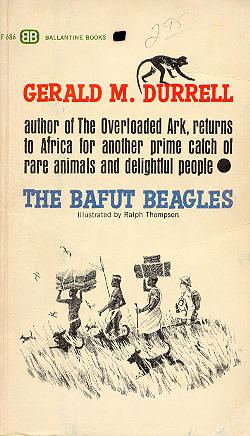The Bafut Beagles
Gerald Durrell

This month, we’re going on a literary safari to West Africa, by way of The Bafut Beagles, a delightful book by Gerald Durrell. Mr. Durrell, who passed away a couple of years ago, was born in India to British parents in 1925. During his childhood, he and his family lived in several different places in Europe, including the Greek island of Corfu. From the time he was a small boy, the author knew that he wanted no other career than one having to do with animals. He studied them from an early age, and eventually realized his dream of having a zoo of his own, the Jersey Wildlife Preservation Trust, on the Channel Island of Jersey. During the course of establishing his zoo, Mr. Durrell made numerous collecting trips to various exotic locales, and slowly gathered the animals that would grace his faunal establishment.
In 1949, Durrell and his assistant headed for the West African country of the Cameroons to see what sort of animals they could acquire. They decided to concentrate on the inland, mountainous region of the country, having collected animals from the coastal rain forest area on an earlier expedition. The region covered in this trip would be the area known as Bafut, a back-country Eden blessed by a healthful climate, masses of rare native fauna, and a most engaging ruler, known as the Fon of Bafut.
Durrell writes thus in The Bafut Beagles:
“In order to hunt for the various members of the Bafut fauna I employed, besides the four hunters the Fon had supplied, a pack of six thin, ungainly mongrels, who, their owners assured me, were the finest hunting dogs in West Africa. I called this untidy ensemble of men and dogs the Bafut Beagles. Although the hunters did not understand the meaning of the title they grew extremely proud of it, and on one occasion I heard a hunter, when arguing with a member of the local population, proclaim in shrill and indignant tones, “You no go shout me like dat, ma friend! You no savvy dat I be de Bafut Beagle?”
Durrell goes on to relate the adventures to be had in collecting a plethora of animals, all of which are referred to as “beef” by the natives. Here is a brief excerpt from a passage dealing with the capture of a dwarf mongoose, which the hunters decided to smoke out of its hole.
“The first whiff of smoke had hardly drifted in among the rocks when the beast shot out of the hole and into the net with such force that the net was torn from its moorings, and the animal rolled down the slope into the long grass, carrying the net with it. The dogs scrambled after it, barking with excitement, and we followed close on their heels, yelling threats as to what punishment they would receive if they harmed the quarry. However, the beast hardly needed our help, for it was perfectly capable of looking after itself, as we soon found out. It shook itself free of the folds of netting and rose up on its hind legs, revealing itself as a small, slim ginger-coloured mongoose about the size of a stoat. It stood there swaying slightly from side to side, its mouth wide open, uttering the most ear-piercing shrieks I have ever heard from an animal of that size. The dogs pulled up short and surveyed it in consternation. ... Then, suddenly, their courage failed them, and they all turned tail and fled up the hill, leaving the mongoose standing on its hind legs in the field of battle, panting slightly, but still able to screech taunts at their retreating tails.”
The mongoose is eventually subdued and taken back to base camp, along with an amazing number of other creatures. From squirrels to skinks, bush cats to galagos, rock hyraxes to hairy frogs, the African bush springs vividly to life under Durrell’s pen. The Bafut Beagles is one of this writer’s most enjoyable and informative books - be sure to read all about it!
All Rights Reserved.